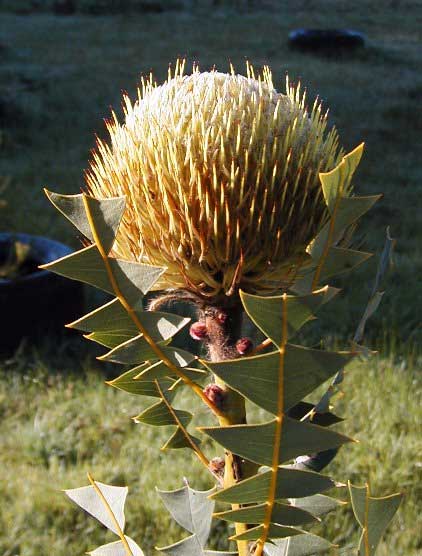
Banksia baxteri (*)
Classification System: APG IV
Superregnum: Eukaryota
Regnum: Plantae
Cladus: Angiosperms
Cladus: Eudicots
Ordo: Proteales
Familia: Proteaceae
Subfamilia: Grevilleoideae
Tribus: Banksieae
Subtribus: Banksiinae
Genus: Banksia
Subgenus: Banksia subg. Banksia
Sectio: Banksia sect. Banksia
Series: Banksia ser. Banksia
Species: B. baxteri
Name
Banksia baxteri R.Br., in Suppl. Prodr. Fl. Nov. Holl. 36 (1830)
Synonyms
Sirmuellera baxteri (R.Br.) Kuntze, Revis. Gen. Pl. 2: 582 (1891)
References
George, A.S. (1999). "Banksia" in Wilson, Annette (ed), Flora of Australia 17B: Proteaceae 3: Hakea to Dryandra: 199. Collingwood, Victoria: CSIRO Publishing / Australian Biological Resources Study. ISBN 0-643-06454-0.
Banksia baxteri, commonly known as Baxter's banksia or bird's nest banksia,[2] is a species of shrub that is endemic to Western Australia. It has greyish brown bark, hairy stems, deeply serrated leaves with triangular lobes and lemon-yellow flowers in an oval flower spike that grows on the end of branches.
Description
Banksia baxteri is an erect shrub that typically groups to a height of 1–5 m (3 ft 3 in – 16 ft 5 in) and that does not form a lignotuber. The branchlets and leaves are densely covered with woolly, white hairs when young. The leaves are wedge-shaped, 70–170 mm (2.8–6.7 in) long and 25–75 mm (0.98–2.95 in) wide in outline on a petiole 5–15 mm (0.20–0.59 in) long, divided to the midlobe with between four and seven triangular lobes on each side surrounded by V-shaped spaces. The flowers are arranged in a broad oval inflorescence 75–86 mm (3.0–3.4 in) wide on the ends of branches, the individual flowers lemon-yellow with a perianth 39–43 mm (1.5–1.7 in) long and the pistil 42–49 mm (1.7–1.9 in) long. Flowering occurs from December to May but mainly from January to March. Only a few follicles 35–42 mm (1.4–1.7 in) long, 17–22 mm (0.67–0.87 in) high and 15–20 mm (0.59–0.79 in) wide develop surrounded by the old flowers.[2][3][4][5]
Taxonomy and naming
Banksia baxteri was first formally described in 1830 by Robert Brown in the supplement to his Prodromus. The type specimens were collected by William Baxter in the mountains near King George Sound in 1829.[6][7]
In 1891, Otto Kuntze, in his Revisio Generum Plantarum, rejected the generic name Banksia L.f., on the grounds that the name Banksia had previously been published in 1776 as Banksia J.R.Forst & G.Forst, referring to the genus now known as Pimelea. Kuntze proposed Sirmuellera as an alternative, referring to this species as Sirmuellera baxteri.[8] This application of the principle of priority was largely ignored by Kuntze's contemporaries,[9] and Banksia L.f. was formally conserved and Sirmuellera rejected in 1940.[10]
Distribution and habitat
Baxter's banksia grows with other shrubs such as Lambertia inermis, usually in deep sand and mostly occurs within 50 km (31 mi) of the coast between East Mount Barren and Israelite Bay.[4]
Conservation status
This banksia is classified as "not threatened" by the Western Australian Government Department of Parks and Wildlife.[5]
Ecology
A 1980 field study at Cheyne Beach showed it to be pollinated by the New Holland honeyeater and white-cheeked honeyeater.[11]
Banksia baxteri is serotinous, that is, it has an aerial seed bank in its canopy in the form of the follicles of the old flower spikes. These are opened with fire and release seed in large numbers, which germinate and grow after rain. Seed can last for many years; old spikes 9 to 12 years old have been found to have seed that remains 100% viable.[12]
Use in horticulture
Seeds do not require any treatment, and take 21 to 42 days to germinate.[13]
References
"Banksia baxteri". Australian Plant Census. Retrieved 2 April 2020.
Hulak, Rosemary. "Banksia baxteri". Australian National Botanic Gardens. Retrieved 2 April 2020.
George, Alex S. (1999). Flora of Australia (PDF). Vol. 17B. Canberra: Australian Biological Resources Study, Canberra. p. 200. Retrieved 2 April 2020.
George, Alex S. (1981). "The genus Banksia L.f. (Proteaceae)". Nuytsia. 3 (3): 330–333. Retrieved 2 April 2020.
"Banksia baxteri". FloraBase. Western Australian Government Department of Biodiversity, Conservation and Attractions.
"Banksia baxteri". APNI. Retrieved 2 April 2020.
Brown, Robert (1830). Supplementum primum prodromi florae Novae Hollandiae: Proteaceas Novas. London: Typis Ricardi Taylor. p. 36. Retrieved 2 April 2020.
Kuntze, Otto (1891). Revisio generum plantarum. Vol. 2. Leipzig: Arthur Felix. pp. 581–582.
Rehder, A.; Weatherby, C. A.; Mansfeld, R.; Green, M. L. (1935). "Conservation of Later Generic Homonyms". Bulletin of Miscellaneous Information (Royal Botanic Gardens, Kew). 1935 (6/9): 368. doi:10.2307/4107078. JSTOR 4107078.
Sprague, T. A. (1940). "Additional Nomina Generica Conservanda (Pteridophyta and Phanerogamae)". Royal Botanic Gardens, Kew. 1940 (3): 99. doi:10.2307/4111642. JSTOR 4111642.
Hopper, Stephen D. (1980). "Bird and Mammal Pollen Vectors in Banksia Communities at Cheyne Beach, Western Australia". Australian Journal of Botany. 28 (1): 61–75. doi:10.1071/BT9800061.
Lamont, Byron B.; Le Maitre, D. C.; Cowling, R. M.; Enright, N. J. (1991). "Canopy seed storage in woody plants". The Botanical Review. 57 (4): 277–317. doi:10.1007/BF02858770. S2CID 37245625.
Sweedman, Luke; Merritt, David, eds. (2006). Australian seeds: a guide to their collection, identification and biology. CSIRO Publishing. p. 202. ISBN 0-643-09298-6.
Taylor, Anne; Hopper, Stephen (1988). The Banksia Atlas (Australian Flora and Fauna Series Number 8). Canberra: Australian Government Publishing Service. ISBN 0-644-07124-9.
Retrieved from "http://en.wikipedia.org/"
All text is available under the terms of the GNU Free Documentation License

